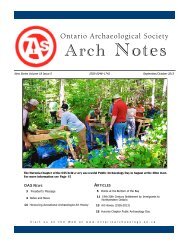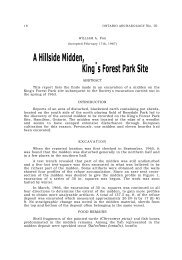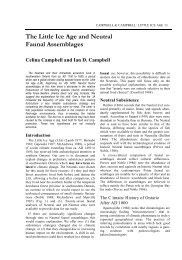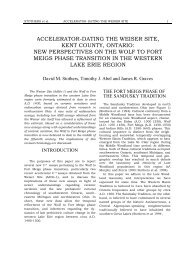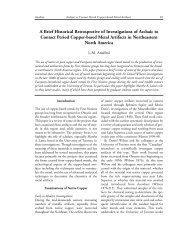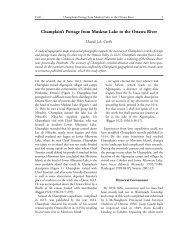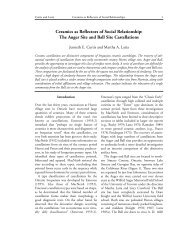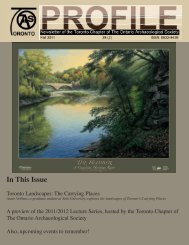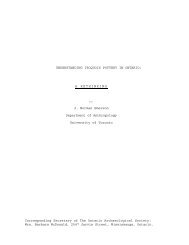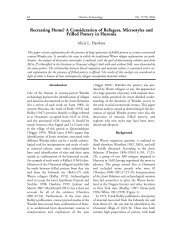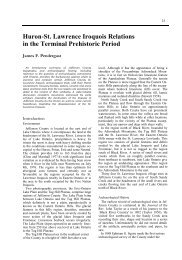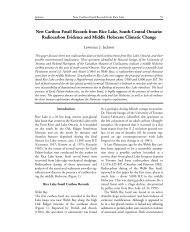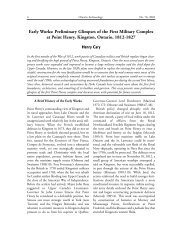oa 74 part 01 pilon layout - Ontario Archaeological Society
oa 74 part 01 pilon layout - Ontario Archaeological Society
oa 74 part 01 pilon layout - Ontario Archaeological Society
- No tags were found...
Create successful ePaper yourself
Turn your PDF publications into a flip-book with our unique Google optimized e-Paper software.
Pilon A Stone Tool Cache from the Hudson Bay Lowlands 13heavily used projection thus formed has the outwardappearance of an angle burin, however burinblows were definitely not involved in its production.This piece also exhibits a secondary projectionshowing use and minimal unifacial shaping.Notches (Figure 8d-f)Five items have been tentatively described asnotches. All are manufactured on flakes andcould initially be lumped together with theretouched/used flakes since their modification islimited to portions of their lateral margins.However, they all consist of intentionally flaked,steep-angled, unifacial concavities. These notchescould be interpreted as useful in attaching orsecuring the implements to hafts, but there isusually no other worked edge.One notable specimen is a large scraper with justsuch a concavity placed on a lateral margin (fortabulation purposes, this specimen is includedunder the scraper category) adjoining the scrapingface (GfJi-2:105). Two other cases exhibit minorretouch or use-wear along other portions of theirmargins (Figure 8d,e). One artifact was made onthe distal end of a medium sized flake that terminatedin a hinge fracture. It consists of two unifaciallyflaked concavities or notches separated by theextremity of the narrow hinge fracture.It would appear that these notches were not typicallycombined with other types of working edgesand thus they likely were used in separate functions,rather than combined in a more complexprocess. One final observation relates to the widthof the notches. If these were used to scrape andotherwise smooth shafts, in the way that spokeshaveswere employed, for example, they would beof relatively small diameters, on the order of lessthan one cm. Some are in fact on the order of threeto four mm. The smaller examples might havebeen used to process cordage, bark or sinew.CoresSeveral pieces in the cache attest to core platformareas and core rotation. These cores are all madefrom river cobbles of Hudson Bay Lowlandchert, as attested by a high incidence of cortex onmany of the flakes. Two items were retained ascore remnants. In reality, others could fit intothis category but they may just as easily bedescribed as chipping detritus.Retouched/Used FlakesA total of 13 flakes was determined to have marginalretouch or signs of use-wear (as determinedwith a 10x hand lens) that appeared to be morethan incidental edge damage that could havebeen caused by the conditions surrounding theirmanufacture and transport. Rather, they appearto represent the remains of either systematic edgemodification or scars from intentional use. Smallnicks and chips were quite common throughoutthe flake collection. Much of this damage doesnot seem to be the result of casual use.The flakes that did exhibit clear and extensiveretouch or use-wear are generally large. Three ofthese flakes bore, in addition to the edge retouch oruse wear, deliberately produced notches, probablyused to smooth shafts or items being made fromorganic materials (see Notches above). The averagedimensions of this category of expedient tool are:3.4 cm x 2.3 cm x 5.6 mm. In terms of the sizeclasses established for the debitage, the mean valuewould be in the second largest flake size class.Scrapers (Figure 9)As might be expected with such a large collectionof scrapers, there is a considerable amount ofvariation in terms of both size and shape. It isvery tempting to group the implements intomutually exclusive categories. Indeed, I didexactly that in describing the scrapers in a previousanalysis (Pilon 1987). However, upon reflectionand more careful study of the collection, itbecomes apparent there is a gradation of blankshapes that were apparently sought by thecraftsperson. These include square and rectangularspecimens (29). However, the sides of some of thescrapers are not parallel, but contracting orexpanding (30) to various degrees and are generallytermed triangular by many authors. Still otherexamples (3) are more irregular in shape and couldbe described as circular. The mean dimensions ofall the scrapers in this cache are 3.0 cm x 2.7 cm x7 mm. These figures include, however, the large,clearly shaped triangular specimen (Figure 9a).When it is excluded from consideration, the mean



